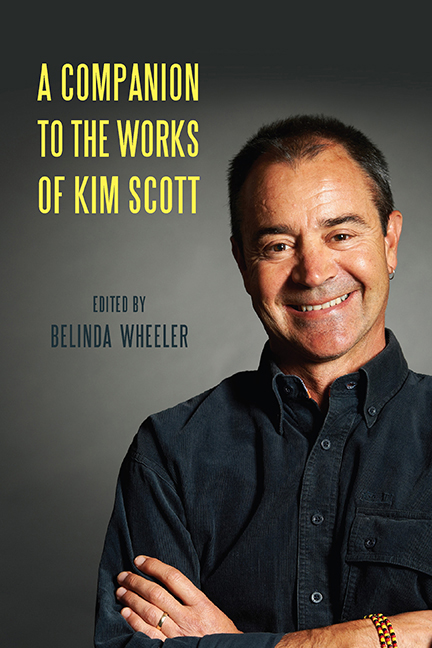Book contents
- Frontmatter
- Contents
- Foreword
- Acknowledgments
- Note on Orthography
- Chronology of Key Writings
- Introduction
- 1 Kim Scott’s Publishing History in Three Contexts: Australian Aboriginal, National, and International
- 2 Kim Scott’s True Country as Aboriginal Bildungsroman
- 3 The Land Holds All Things: Kim Scott’s Benang—A Guide to Postcolonial Spatiality
- 4 Kim Scott’s Kayang and Me: Noongar Identity and Evidence of Connection to Country
- 5 “Wreck/Con/Silly/Nation”: Mimicry, Strategic Essentialism, and the “Friendly Frontier” in Kim Scott’s That Deadman Dance
- 6 The International Reception of Kim Scott’s Works: A Case Study Featuring Benang
- 7 Traumatic Landscapes: Inscribing Spectrality and Identity in Kim Scott’s “A Refreshing Sleep,” “Capture,” and “An Intimate Act”
- 8 Spatial Poetics and the Uses of Ekphrasis in Kim Scott’s “Into the Light” and Other Stories
- 9 The Poetry of Kim Scott
- 10 The Wirlomin Project and Kim Scott: Empowering Regional Narratives in a Globalized World of Literature
- 11 Kim Scott as Boundary Rider: Exploring Possibilities and New Frontiers in Aboriginal Health
- 12 An Interview with Kim Scott
- Notes on the Contributors
- Index
Foreword
Published online by Cambridge University Press: 08 May 2021
- Frontmatter
- Contents
- Foreword
- Acknowledgments
- Note on Orthography
- Chronology of Key Writings
- Introduction
- 1 Kim Scott’s Publishing History in Three Contexts: Australian Aboriginal, National, and International
- 2 Kim Scott’s True Country as Aboriginal Bildungsroman
- 3 The Land Holds All Things: Kim Scott’s Benang—A Guide to Postcolonial Spatiality
- 4 Kim Scott’s Kayang and Me: Noongar Identity and Evidence of Connection to Country
- 5 “Wreck/Con/Silly/Nation”: Mimicry, Strategic Essentialism, and the “Friendly Frontier” in Kim Scott’s That Deadman Dance
- 6 The International Reception of Kim Scott’s Works: A Case Study Featuring Benang
- 7 Traumatic Landscapes: Inscribing Spectrality and Identity in Kim Scott’s “A Refreshing Sleep,” “Capture,” and “An Intimate Act”
- 8 Spatial Poetics and the Uses of Ekphrasis in Kim Scott’s “Into the Light” and Other Stories
- 9 The Poetry of Kim Scott
- 10 The Wirlomin Project and Kim Scott: Empowering Regional Narratives in a Globalized World of Literature
- 11 Kim Scott as Boundary Rider: Exploring Possibilities and New Frontiers in Aboriginal Health
- 12 An Interview with Kim Scott
- Notes on the Contributors
- Index
Summary
IN HIS REVIEW of a seminal collection of established and emerging Aboriginal writers, Paperbark: A Collection of Black Australian Writing (1990), the literary critic David Headon predicted that the 1990s would be “a hectic and bountiful decade” for Australian Aboriginal literature. Headon's prediction was realized. The 1990s and 2000s witnessed increased Aboriginal resistance and activism and evidence of new energies within Aboriginal literature. Australia entered the new millennium with racial issues still unresolved. Through the Centenary of Federation (1901–2001), the History Wars (1980s–2000s), the 2007 Northern Territory Intervention, the election of the Rudd government in 2008, and the prime minister's “National Apology to the Stolen Generations” in 2008, Aboriginal writing has continued to grow in genre and geography.
Belinda Wheeler noted in the introduction to A Companion to Australian Aboriginal Literature (2013) that from its nascent beginnings in the 1920s there is an emerging and growing canon in Aboriginal literature. This body of writing extends beyond the literary sphere—it is a cultural project that writes beneath, across, and above the nation—and its presence has intervened significantly in the literary and cultural history of Australia.
Prominent within this canon is the Noongar writer and scholar Kim Scott. Scott's ancestral country is the southwestern corner of Western Australia between the Gairdner River and Cape Arid. His clan is Wirlomin. Since the mid-nineties Scott's clan has spoken through his poetry, short stories, novels, children's literature, language books, and scholarly works—some of which have received wide critical acclaim in Australia and abroad. This volume brings together an impressive collection of Australian and international scholars in discussions of Scott's works regionally, nationally, and internationally.
Australia is a modern nation that comprises many Aboriginal countries. The term country is used by Aboriginal people to describe family origins and continued relationships to a particular place. Country means more than just land. It is local, but it stretches toward something larger. Country is a state of mind in that it includes the memories of a people in a particular place past and present, but it also connects to tangibles such as lands, waters, and the lives they sustain.
- Type
- Chapter
- Information
- A Companion to the Works of Kim Scott , pp. vii - viiiPublisher: Boydell & BrewerPrint publication year: 2016

